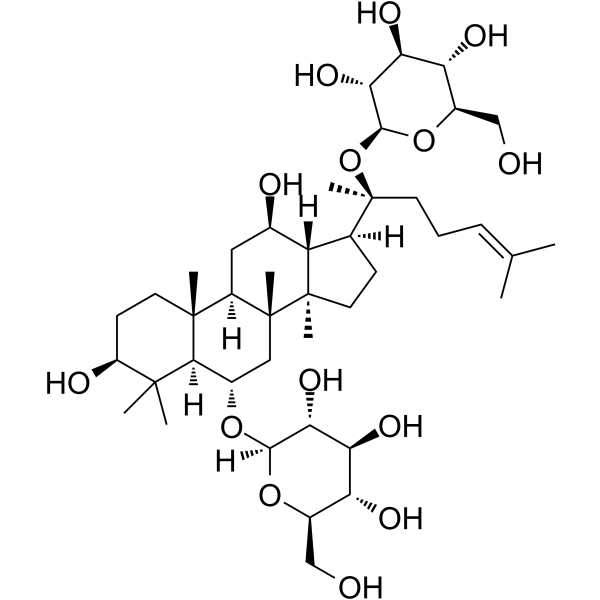天然产物 糖类和糖苷 Saccharides and Glycosides
Ginsenoside Rg1;(Synonyms: 人参皂苷 Rg1; Panaxoside A; Panaxoside Rg1) 纯度: ge;98.0%
Ginsenoside Rg1 是人参的主要活性成分之一。Ginsenoside Rg1 改善认知功能受损,通过降低大脑 Aβ 水平来发挥作用。Ginsenoside Rg1 减少 NF-κB 核易位。

Ginsenoside Rg1 Chemical Structure
CAS No. : 22427-39-0
| 规格 | 价格 | 是否有货 | 数量 |
|---|---|---|---|
| Free Sample (0.1-0.5 mg) | ; | Apply now | ; |
| 10;mM;*;1 mL in DMSO | ¥1057 | In-stock | |
| 5 mg | ¥700 | In-stock | |
| 10 mg | ¥1200 | In-stock | |
| 50 mg | ¥3600 | In-stock | |
| 100 mg | ; | 询价 | ; |
| 200 mg | ; | 询价 | ; |
* Please select Quantity before adding items.
Ginsenoside Rg1 相关产品
bull;相关化合物库:
- Natural Product Library Plus
- Bioactive Compound Library Plus
- Apoptosis Compound Library
- Immunology/Inflammation Compound Library
- Neuronal Signaling Compound Library
- NF-kappa;B Signaling Compound Library
- Stem Cell Signaling Compound Library
- Natural Product Library
- Anti-Cancer Compound Library
- Anti-Aging Compound Library
- Antioxidants Compound Library
- Differentiation Inducing Compound Library
- Glycoside Compound Library
- Lipid Compound Library
- Oxygen Sensing Compound Library
- Medicine Food Homology Compound Library
- Terpenoids Library
- Pyroptosis Compound Library
- Traditional Chinese Medicine Monomer Library
- FDA Approved amp; Pharmacopeial Drug Library
- Anti-Alzheimer’s Disease Compound Library
- Anti-Breast Cancer Compound Library
- Anti-Pancreatic Cancer Compound Library
- Anti-Blood Cancer Compound Library
- Neurodegenerative Disease-related Compound Library
- Anti-Obesity Compound Library
- Transcription Factor Targeted Library
- Food-Sourced Compound Library
- Anti-Liver Cancer Compound Library
| 生物活性 |
Ginsenoside Rg1 is one of the major active components of ginseng. Ginsenoside Rg1 ameliorates the impaired cognitive function, displays promising effects by reducing cerebral Aβ levels. Ginsenoside Rg1 also reduces NF-κB nuclear translocation. |
||||||||||||||||
|---|---|---|---|---|---|---|---|---|---|---|---|---|---|---|---|---|---|
| IC50 Target[1][2] |
|
||||||||||||||||
| 体外研究 (In Vitro) |
Ginsenoside Rg1 promotes the proliferation and differentiation of human dental pulp cells (hDPCs). The proliferative ability of hDPCs in Ginsenoside Rg1 is significantly enhanced (p<0.05), especially in the Ginsenoside Rg1 (5 μM) group. ALP activity and gene expressions of DSPP and DMP1 are increased in the induction group, Ginsenoside Rg1 group, and their combination group compared with the control group (p<0.05)[3]. In the RAW264.7 cells stimulated by lipopolysaccharides (LPS) , the level of p-IκBα and p-p65 is significantly higher than in controls and PPAR-γ levels are significantly lower. Treatment with Rg1 vitro inhibits IκBα phosphorylation, reduces NF-κB nuclear translocation and upregulates PPAR-γ expression[2]. MCE has not independently confirmed the accuracy of these methods. They are for reference only. |
||||||||||||||||
| 体内研究 (In Vivo) |
In the inflamed joints of adjuvant-induced arthritis (AIA) rats, the level of p-IκBα and p-p65 is significantly higher than in controls and PPAR-γ levels are significantly lower. Treatment with Ginsenoside Rg1 in vivo inhibits IκBα phosphorylation, reduces NF-κB nuclear translocation and upregulates PPAR-γ expression[2]. Ginsenoside Rg1 (G-Rg1) and Ginsenoside Rg2 (G-Rg2) reduce the escape latencies on the last two training days compared to the Alzheimer’s disease (AD) model group (p<0.05). In the spatial exploration test, the total time spent in the target quadrant and the number of mice that exactly crossed the previous position of the platform are clearly shorter and lower, respectively, in the AD model group mice than in the normal control group mice (p<0.01), a trend that is reversed by treatment with Ginsenoside Rg1 and Ginsenoside Rg2 (Ginsenoside Rg1, p<0.01; Ginsenoside Rg2, p<0.05). Treatment with Ginsenoside Rg1 and Ginsenoside Rg2 effectively improve cognitive function of the mice that have declined due to AD. Ginsenoside Rg1 and Ginsenoside Rg2 reduce Aβ1-42 accumulation in APP/PS1 mice. In the Ginsenoside Rg1 and Ginsenoside Rg2 treated mice, the pathological abnormalities observed in the APP/PS1 mice are gradually ameliorated. Clear nucleoli and light brown, sparsely scattered Aβ deposits are visible[1]. MCE has not independently confirmed the accuracy of these methods. They are for reference only. |
||||||||||||||||
| 分子量 |
801.01 |
||||||||||||||||
| Formula |
C42H72O14 |
||||||||||||||||
| CAS 号 |
22427-39-0 |
||||||||||||||||
| 中文名称 |
人参皂苷 Rg1 |
||||||||||||||||
| 运输条件 |
Room temperature in continental US; may vary elsewhere. |
||||||||||||||||
| 储存方式 |
|
||||||||||||||||
| 溶解性数据 |
In Vitro:;
DMSO : ≥ 100 mg/mL (124.84 mM) * “≥” means soluble, but saturation unknown. 配制储备液
*
请根据产品在不同溶剂中的溶解度选择合适的溶剂配制储备液;一旦配成溶液,请分装保存,避免反复冻融造成的产品失效。 In Vivo:
请根据您的实验动物和给药方式选择适当的溶解方案。以下溶解方案都请先按照 In Vitro 方式配制澄清的储备液,再依次添加助溶剂: ——为保证实验结果的可靠性,澄清的储备液可以根据储存条件,适当保存;体内实验的工作液,建议您现用现配,当天使用; 以下溶剂前显示的百
|
||||||||||||||||
| 参考文献 |
|
| Cell Assay [3] |
hDPCs are incubated with different concentrations of Ginsenoside Rg1 (0.1, 0.5, 2.5, 5, 10 and 20 μM) . The effects of Ginsenoside Rg1 on the proliferative ability of hDPCs are evaluated by a fibroblast colony forming test, MTT assay and flow cytometry for cell cycle. The control group, osteogenic induction group, Ginsenoside Rg1 (5 μM) group and combination group are designed, and alkaline phosphatase (ALP) activity and FQ-PCR for gene expressions of dentine sialophosphoprotein (DSPP) and dentine matrix protein 1 (DMP1) are performed to evaluate the differentiation of hDPCs[3]. MCE has not independently confirmed the accuracy of these methods. They are for reference only. |
|---|---|
| Animal Administration [1] |
Mice[1] MCE has not independently confirmed the accuracy of these methods. They are for reference only. |
| 参考文献 |
|
